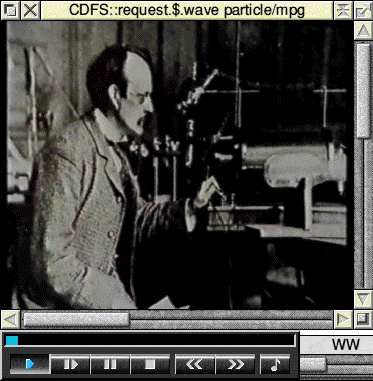



The Education Column
Andrew Harmsworth with the latest Education news
This month I take a look a service I recently discovered that has taken science teachers at my school by storm. Furthermore we have the results of last column's competition.
Science Video Network
If you're not a science teacher, get ready to tell this to someone who is. If you're a teacher, but not of science, get ready to be jealous - and maybe think about setting up a scheme like this for your own subject.
For a number of years I've occasionally enjoyed the ability to download MPEG movies from the web to then play time and time again in a classroom situation. Having a digital video is so much more convenient than cumbersome VHS tapes that wear out through use and require rewinding or forwarding to the correct location. More often than not you only require a few minutes of a video to demonstrate the point, rather than the whole programme itself. Digital video allows this so easily.
Unfortunately the cost of digitising a science department's VHS collection is rather high, and the time required inconvenient. Furthermore the quality of freely-available video footage on the web is often questionable. Channel 4 recently launched a range of CD ROMs that they call TV ROMs as they contain broadcast-quality video footage. These are great, but they're not cheap.

Only last month I stumbled across an amazing service called the Science Video Network (SVN). This seemed too good to be true, but it turns out not to be! For sixty nominal pounds per year, a school science department can join to gain access to a large catalogue of MPEG videos of previously-broadcast science television programmes. For the price of 4 or 5 standard VHS pre-recorded videos, what do you get?
The Starter Pack
I emailed the SVN who sent me a sample MPEG of the famous NASA astronaut dropping a hammer and a feather on the moon. This was great as I was just about to teach air resistance and terminal velocity to my year 10! I was so amazed by this that I emailed them an order number to join.
The following day a huge parcel arrived for me. It contained a rather nice CD wallet containing 30 CDs, 10 each of Biology, Chemistry and Physics. Each CD contained 2-4 programmes totalling an hour in length. 90 in total. £60 for this lot is an absolute bargain, but that's just the start...
Members are entitled to request videos from a catalogue of over 400 programmes that cover key stages 3-5 (for further information on key stages, visit the ROSES website). These can either be emailed to you, if the file size is under 15MB, or burnt onto CD and posted to you at no extra charge. Yes that's right: at no extra charge.

Fig. 1: CD of requested videos
Copyright Issues
Schools have a licence from the Educational Recording Agency (ERA) that entitles teacher to record broadcasts for the purposes of teaching. This licence also allows us to swap programmes with each other. The SVN is just a scheme that allows effective sharing of these wonderful resources. There is of course absolutely no reason why other teachers of other subjects shouldn't share broadcast videos in this way and I would hope that if anyone falls into this category, or knows someone who does, they will see what they can do.
RISC OS Compatibility
Playing MPEG video on RISC OS machines is not easy. However a basic StrongARM RiscPC can cope. My machine's specification is 202MHz StrongARM, 2MB VRAM, and 48MB RAM. KinoAMP is my player of choice, as it has a great desktop user interface and supports sound playback. My CD ROM drive is only 8×, and can just about cope with playing the videos. More recent speeds will cope admirably. Make sure your CD ROM buffer is at maximum: 512K.

Fig. 2: J J Thomson, who opened my department 76 years ago,
discovering the electron
 I have no doubt that a nice shiny new Iyonix would be able to play more than one video at once, but I've no idea why you would want to do this! Anyway whilst not strictly software, this scheme is the best thing ever so it gets the RISC World seal of approval.
I have no doubt that a nice shiny new Iyonix would be able to play more than one video at once, but I've no idea why you would want to do this! Anyway whilst not strictly software, this scheme is the best thing ever so it gets the RISC World seal of approval.
- Web link: www.sciencevideonetwork.org
Competition Winner!
Most of you will recall the tricky question we posed in the last issue coinciding with the article on CLIC software. The question was:
What does CLIC stand for?
And the answer was, of course:
There were a large number of emails in my email box with the answer, and the first out of the e-hat was Geoff Potter of Thornton Heath. Very well done to Geoff - I'll put your CD in the post shortly.
Thanks to everyone else who entered, and better luck next time!
If you have any questions or comments on the use of RISC OS computers in education, please either email education@harmsy.freeuk.com or better still join the RISC OS Education Discussion List, and air them there.
Andrew Harmsworth